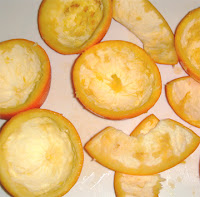 Following the theme of recreating Williams Sonoma food gift ideas, I wanted to share with you our latest knock-off. It's the caramel covered marshmallow treat. Also called Modjeskas, these candies were purportedly named after a beautiful Polish actress by an admirer.
Following the theme of recreating Williams Sonoma food gift ideas, I wanted to share with you our latest knock-off. It's the caramel covered marshmallow treat. Also called Modjeskas, these candies were purportedly named after a beautiful Polish actress by an admirer. Anyway, they look a heck of a lot more complicated to make than they actually are. These make great gifts wrapped in wax paper. Especially when you aren't paying $27 a pound for them!
To make the marshmallows:
Ingredients
1 cup confectioners' sugar
2 tablespoons plus 2 1/2 teaspoons unflavored gelatin
1/2 cup cold water
2 cups granulated sugar
1/2 cup light corn syrup
1/2 cup hot water (about 115 degrees)
1/4 teaspoon salt
2 large egg whites
1 teaspoon vanilla
Directions
Oil bottom and sides of a 13 by 9 by 2-inch rectangular metal baking pan and dust bottom and sides with some confectioners' sugar.
In bowl of standing electric mixer, sprinkle gelatin over cold water and let stand to soften.
In a 3-quart heavy saucepan cook granulated sugar, corn syrup, hot water, and salt over low heat, stirring with a wooden spoon, until sugar is dissolved. Increase heat to moderate and boil mixture, without stirring, until a candy or digital thermometer registers 240 degrees, about 12 minutes. Remove pan from heat and pour sugar mixture over gelatin mixture, stirring until gelatin is dissolved.
With standing mixer beat on high speed until white, thick and nearly tripled in volume, about 6 minutes. In a large bowl with cleaned beaters beat whites (or reconstituted powdered whites) until they just hold stiff peaks. Beat whites and vanilla into sugar mixture until just combined. Pour mixture into baking pan and sift 1/4 cup confectioners' sugar evenly over top. Chill marshmallow, uncovered, until firm, at least three hours, and up to 1 day.
Run a thin knife around edges of pan and invert pan onto large cutting board. Lifting up 1 corner of inverted pan, with fingers loosen marshmallow and let drop onto cutting board. With a large knife trim edges of marshmallow and cut marshmallows into roughly 1-inch cubes. Sift remaining confectioners' sugar into a large bowl and add marshmallows in batches, tossing to evenly coat. Marshmallows (without caramel) keep in an airtight container at cool room temperature for 1 week.
To make the caramel:
Ingredients
1 cup sugar
1 cup light corn syrup
1/2 cup cream
1/4 cup water
1 tbsp butter
1 tsp vanilla extract
1/8 tsp salt
16 marshmallows (see recipe above)
Wax paper
Directions
Cut the wax paper into 2 inch x 3 inch wide strips. You may need to adjust the size of your wax paper depending on how big your marshmallows are.
Place the sugar, water, cream, and corn syrup in a small saucepan over medium heat, stirring constantly until the sugar dissolves. Stir in the butter until it is melted. Continue to cook, stirring occasionally until the caramel reaches 238 degrees, then remove from the heat.
Stir in the vanilla and salt. Allow the caramel to thicken and cool for 10-15 minutes until it cools to about 175 degrees.
To dip the marshmallows:
Using a fork, drop a marshmallow into the caramel and turn it over until it is completely covered. Remove the marshmallow from the caramel, letting excess caramel drip off. Place the marshmallow on a piece of wax paper.
Continue dipping with the remaining marshmallows. If the caramel becomes too stiff, place it over the heat for a minute or two until it becomes easy to work with.
Allow the candies to set fully at room temperature before wrapping. Store excess candies in an airtight container at room temperature.

































